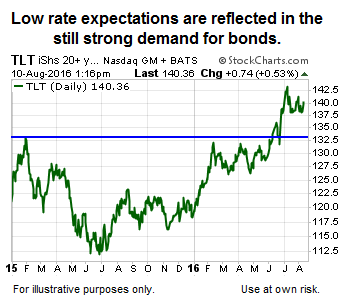Low Productivity And Excessive Debt Fueled By Ultra-Low Rates
Global central planners often cite high global debt levels and decreasing productivity as valid reasons to extend the QE/zero/negative rate era. From the front page of Wednesday’s Wall Street Journal:
The longest slide in worker productivity since the late 1970s is haunting the U.S. economy’s long-term prospects, a force that could prompt Federal Reserve officials to keep interest rates low for years to come. Nonfarm business productivity—the goods and services produced each hour by American workers—decreased at a 0.5% seasonally adjusted annual rate in the second quarter as hours worked increased faster than output, the Labor Department said Tuesday. It was the third consecutive quarter of falling productivity, the longest streak since 1979.
Low-Rate Loans Lead To Unproductive Projects
Let’s assume you were running a company years ago when the going rate for a business loan was 8%. As someone responsible for producing profits, you would have to come up with a creative and productive idea in order to borrow money at 8%. Marginal ideas rarely get implemented at 8% since the return on investment will not even cover the interest payments on the loan.
As rates get lower and lower, the hurdle rate for borrowing money gets lower and lower, which means numerous less-productive and less-creative ideas can be put into production. These concepts were outlined in the context of easy central bank policy on July 16. Therefore, central bank policy is contributing to low productivity. Ironically, central banks will use low productivity as an excuse to keep rates ultra-low.
Bailouts Lead To Low Productivity

In what now seems to be a distant memory, there was a time when a major financial institution or industrial company failed to bring productive and profitable ideas to the free markets, they were weeded out of the economic garden via the laws of supply and demand.
Bankruptcies and debt defaults penalize companies that specialize in unproductive projects. Bailouts and band aids keep unproductive companies in business, which also helps drag down overall productivity. Low productivity also leads to low worker morale, which in turn can lead to populist movements (see U.K. and United States).
Central Planners Concerned About High Debt Levels
Given their printing presses and zero/negative rate policies have spurred a gigantic boom in unproductive borrowing, it is almost comical that central bankers are expressing concerns about too much debt. From CNBC:
Central bankers from the U.S., India and Malaysia pointed to debt as a key factor holding back the global economic recovery from the financial crisis.
Dr. Zeti Aziz, who recently retired as Malaysia’s central bank chief after serving from 2000-2016, added that it wasn’t just public indebtedness hurting fiscal spending, but also private sector debt weighing on growth.
However, Rajan noted that one cause of slow growth may come from continued easy monetary policy globally.
“Perhaps the pressure on poorly performing firms to get out of business has been lower than otherwise,” he noted. “What is called the zombie problem by some economists in Japan may be more prevalent than in other areas of the world because if easy access to finance.”
Why Is There Too Much Debt?

There are numerous reasons for high debt levels and low productivity, but extremely low interest rates and bailouts are a good place to start. Recessions, like other processes in nature, help identify weak players in the public and private sector. During recessions, the rate of bond defaults increases, which is a natural way to purge bad debt from the global economy. The problem is central planners have pumped up asset prices to such lofty and artificial levels, central bankers fear that letting economic natural selection into the debt-purging process could set off a hard to stop deflationary spiral in asset prices. Below are just a few examples from the central planning bailout collection:
- $17.4 Billion Bailout U.S. Auto Industry
- Insurance Company Bailout
- U.S. Bank Bailout
- European Bank Bailout
- Third Bailout For Greece
Investment Implications: Central Banks Will Continue To Print And Prop Up
Instead of nearing the end of the easy money era, central banks are moving toward becoming even easier. From The Wall Street Journal:
The BOE’s revival of its QE program was accompanied by an interest-rate cut and a new funding program for banks. It also said it intends to buy some £10 billion of corporate bonds alongside its gilt purchases. The central bank was reacting to what it sees as a darkening outlook for the U.K. economy following the Brexit vote. Officials said they expect growth to slow and inflation to rise amid the uncertainty caused by the surprise result.
The low-rate game can continue, but central banks’ ability to keep asset markets in line will greatly diminish if the U.S. slips into a recession and/or inflation starts to rise. For now, the recent breakouts in stocks, bonds, and gold are holding up, aligning with the market’s expectations central banks have numerous hands to play, including firing up money-dropping helicopters.
